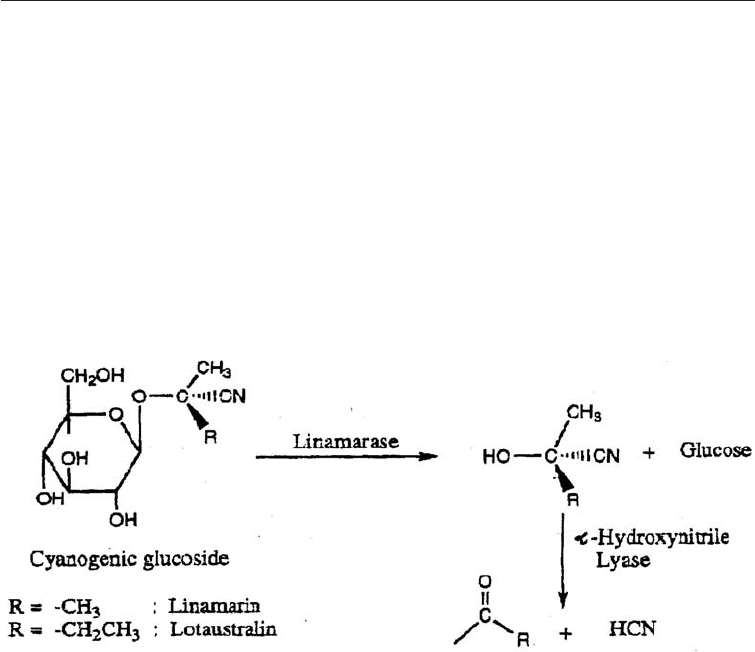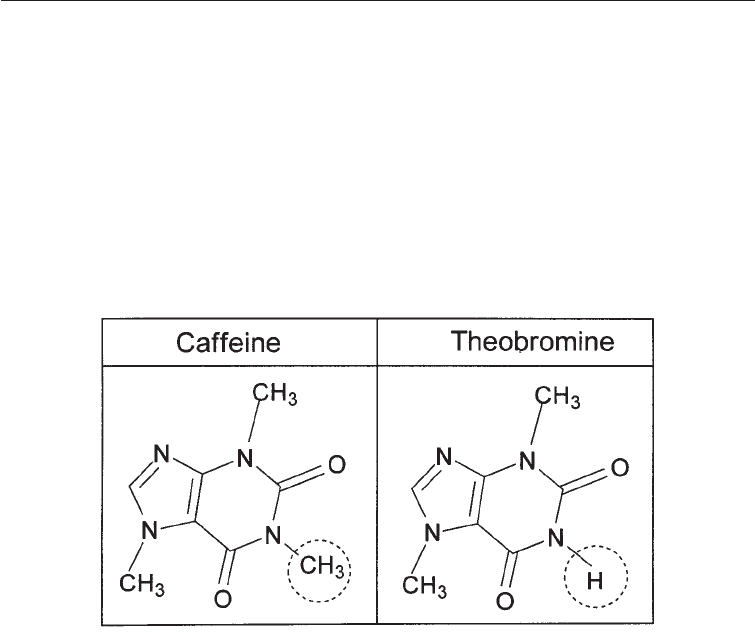Okafor N. Modern Industrial Microbiology and Biotechnology
Подождите немного. Документ загружается.


!# Modern Industrial Microbiology and Biotechnology
19.5 FERMENTED FOODS FROM CASSAVA: GARRI, FOO-FOO,
CHIKWUANGE, KOKONTE, BIKEDI, AND CINGUADA
Cassava is an important source of food all over the tropical world in South America,
Africa, India and the Far East. Botanically it is a member of the family Euphorbiaceae and
is classified as Manihot esculenta Crantz (formerly Manihot utillisaima Pohl). It has a
number of synonyms around the world: manioc (Madagascar and French-speaking
Africa) tapioca (India, Malaysia), ubi scetlela (Indonesia) manioca or yucca (Latin
America).The plant tolerates low soil fertility and drought, better than most crops and
needs little maintenance once planted. It has also been claimed to be a higher producer of
carbohydrate then commonly cultivated cereals and tuber crops and under favorable
conditions will yield above 90 ton/hectare. It is therefore not surprising that it is the
staple food in densely populated areas of the tropics such as Central Java in Indonesia,
the State of Kerala in India, south-eastern Nigeria and north-eastern Brazil and is
consumes by an estimated 400 million people around the world. Nigeria is currently the
world’s largest producer followed by Brazil, Indonesia, Zaire, Thailand, and Tanzania.
Cortex
Periderm
Starch granules in cells in the starchy
inner flesh
Starchy inner flesh
Peel
}
Central vascular fiber
Fig. 19.2 Transverse Section of the Cassava Root
A major shortcoming of cassava roots is that they are very low in protein. In addition
many varieties contain the cyanogenic glucosides, linamarin and (to a lesser extent)
lotaustralin. These glucosides can give rise to fatalities if cassava roots are consumed
unprocessed. Cassava may be processed by boiling, roasting, drying, leaching with cold
water, or by fermentation. By far the most popular method of processing cassava is by
fermentation. In producing fermented cassava products, the roots may first be grated
before fermentation, the whole root may be cut into large pieces and fermented in water
(retted). The best known example of foods produced from cassava pulp is garri, while
those produced from the retting of whole roots include foo-foo, chikwuangue, kokonte,
and cinguada.

Production of Fermented Foods !#
19.5.1 Garri
Garri is a popular food for about 100 miilion people in West Africa; in Cote d’Ivoire, atieke,
a food very similar to garri, produced from cassava but is is not fried like garri. A similar
food known as farinha de manioc or farinha de mega is consumed in parts of Brazil.
Preparation of Garri: Garri is currently prepared mostly on small, house-hold scales. The
first stage is the peeling to remove the brownish thin outer covering (Fig. 19.2) to reveal the
white fleshy inner portion which is grated on a hand-held rasper or crushed in a grating
machine. The central pith and primary xylem provide some fibers in the grated material
some of which is removed by sieving, but which is appreciated by some garri consumers.
Grating
Bagging,
Dewatering,
Fermentation
24–96 hours
-
oil
Palm
Added
Optional
Sieving Frying
Peeling of
Cassava roots
Sieving
GARRI
Fig. 19.3 Flow Chart of Garri Production
The mash resulting from the grating is placed in cloth bags for between 18 and
48 hours and fermented. During the period of fermentation, the mash is dewatered by
placing heavy objects on the cloth bags. At the end of the fermentation period, the mash is
sieved through a coarse sieve and heated, sometimes with a little palm oil, in a flat iron
pot with stirring.
Microbiology of the fermentation of Garri: In 1959 Collard and Levi published their study
on the two-stage fermentation of cassava pulp. In the first stage which lasted for the first
48 hours a yellow-pigmented bacterium, Corynebacterium manihot, proliferated. This
organism broke down starch eventually to organic acids including lactic acid. The
resulting drop in pH led to the spontaneous breakdown of the linamarin and the
proliferation of the fungus Geotrichum candidum which produced the flavoring
aldehydes, ketones and other compounds. In 1977 Okafor re-examined fermenting pulp
and while there he found some Corynebacterium, the bulk of the organisms were lactic
acid bacteria, especially Lactobacillus, Leuconostoc and and yeasts. He suggested the
absence of lactic acid bacteria in the work of Collard and Levi was probably because they
used nutrient agar, a medium lacking sugars in which lactic acid bacteria grow better.
Furthermore, linamarin is fairly stable and the glucoside is probably broken down more
by the indigenous linamarase of the enlarged roots, which is released when the roots are
crushed than by a change of pH. Other workers have since confirmed the importance of
lactic acid bacteria and yeasts in the fermentation of cassava during garri production.
The current thinking on the microbiological processes of cassava fermentation for
garri production is that when cassava roots are grated to produce the mash which is
bagged and fried to produce garri, the indigenous linamarase present in the roots is
released and makes contact with the cyanogenic glucosides in the roots. The glucosides,

!# Modern Industrial Microbiology and Biotechnology
mostly linamarin and some lotaustralin (about 5% of the total glucosides) are then broken
down into glucose and HCN (Fig. 19.4). The HCN release is characteristically noticed by
the pungent smell in evidence whenever cassava is being grated. As the amount of the
linamarase is insufficient to hydrolyze all the cyanogenic glucosides or because the
particles are not fine enough to ensure complete contact between the enzyme and the
substrate, there is always residual glucoside which enters the garri as cyanide. Many of
the organisms encountered in fermenting cassava mash are lactic acid bacteria and
yeasts. Lactobacillus, Leuconostoc, the yeast Candida and various other yeasts are
encountered in fermenting cassava mash, and many strains of these have been found to
produce linamarase. By inoculating one of such linamarase producing organisms into
fermenting cassava mash the group was able to almost totally remove the residual
cyanide in garri.
Fig. 19.4 Breakdown of Cassava Cyanogenic Glucosides
19.5.2 Foo-Foo, Chikwuangue, Lafun, Kokonte,
Bikedi, and Cinguada
The preparation of these foods, although eaten in different parts of Africa, is similar. Foo-
foo is eaten in parts of eastern Nigeria, while lafun is eaten in western Nigeria.
Chikwuangue is eaten in Democratic Republic of the Congo, bikedi in Congo
(Brazzaville), kokonte and cinguada are eaten in Ghana and East Africa respectively. In
the preparation of these foods, cassava roots are cut into large pieces and immersed in
still water in pots or in running stream water and allowed to ret for one to five days; for
foo-foo or chikwuangue fermentation retting takes between three and six days so that the
starch can be extracted from the retted roots by macerating with the hands. For kokonte
and cinguada, retting is only partial and hardly lasts more than two days; the material is
then sun-dried and pounded into a flour when it is known as lafun in Nigeria. For foo-foo
and bikedi the retted roots are macerated to extract the starch. The retting is a result of the
breakdown of the pectin in the cell walls of the cassava root brought about by pectinases
produced by bacteria of the genus Bacillus spp., while the lactic acid bacteria are
responsible for the flavor of these foods.

Production of Fermented Foods !#!
19.6 FERMENTED VEGETABLES
Like the fermentation of other foods, vegetables have been preserved by fermentation from
time immemorial by lactic bacterial action. A wide range of vegetables and fruits
including cabbages, olives, cucumber, onions, peppers, green tomatoes, carrots, okra,
celery, and cauliflower have been preserved. Only sauerkraut and cucumbers will be
discussed, as the same general principles apply to the fermentation of all vegetables and
fruits. In general they are fermented in brine, which eliminates other organisms and
encourages the lactic acid bacteria.
19.6.1 Sauerkraut
Sauerkraut is produced by the fermentation of cabbages, Brassica oleracea, and has been
known for a long time. Specially selected varieties which are mild-flavored are used. The
cabbage is sliced into thin pieces known as slaw and preserved in salt water or brine
containing about 2.5% salt. The slaw must be completely immersed in brine to prevent it
from darkening. Kraut fermentation is initiated by Leuconostoc mesenteroides, a
heterofermentative lactic acid bacterium (i.e., it produces lactic acid as well as acetic acid
and CO
2
.) It grows over a wide range of pH and temperature conditions. CO
2
creates
anaerobic conditions and eliminates organisms which might produce enzymes which
can cause the softening of the slaw. CO
2
also encourages the growth of other lactic acid
bacteria. Gram negative coliforms and pseudomonads soon disappear, and give way to a
rapid proliferation of other lactic acid bacteria, including L. brevis, which is
heterofermentative, and the homofermentative L. plantarum; sometimes Pediococcus
cerevisiae also occurs. Compounds which contribute to the flavor of sauerkraut begin to
appear with the increasing growth of the lactics. These compounds include lactic and
acetic acids, ethanol, and volatile compounds such as diacetyl, acetaldehyde, acetal,
isoamyl alcohol, n-hexanol, ethyl lactate, ethyl butarate, and iso amyl acetate. Besides the
2.5% salt, it is important that a temperature of about 15°C be used. Higher temperatures
cause a deterioration of the kraut.
19.6.2 Cucumbers (pickling)
Cucumber (Cucumis sativus) is eaten raw as well after fermentation or pickling.
Cucumbers for pickling are best harvested before they are mature. Mature cucumbers are
too large, ripen easily and are full of mature seeds. Cucumbers may be pickled by dry
salting or by brine salting.
Dry salting is also generally used for cauliflower, peppers, okra, and carrots. It consists of
adding 10 to 12% salt to the water before the cucumbers are placed in the tank. This
prevents bruising or other damage to the vegetables.
Brine salting is more widely used. A lower amount of salt is added, between 5 and 8% salt
being used. Higher amounts were previously used to prevent spoilage. It has been found
that at this salt concentration, the succession of bacteria is similar to that in kraut.
However Leuconostoc spp. never dominate. During the primary fermentation lasting two
or three days, most of the unwanted bacteria disappear allowing the lactics and yeasts to
proliferate. In the final stages, after 10 to 14 days, Lactobacillus plantarum and L. brevis,
followed by Pediococcus, are the major organisms.

!#" Modern Industrial Microbiology and Biotechnology
19.7 FERMENTATIONS FOR THE PRODUCTION OF
THE STIMULANT BEVERAGES: TEA,
COFFEE, AND COCOA
Tea, coffee, and cocoa are produced mainly in the rainforest zones of the Indian sub-
continent and in South America and West Africa respectively. Tea can also grow in the
cooler temperatures of mountains. The beverages are stimulating on account of their
content of either one or the other of two chemically similar stimulants, caffeine and
theobromine (Fig. 19.5). Of the three, only cocoa and coffee are produced by some form of
fermentation; the production of tea is strictly speaking a chemical reaction, but it is
included for completeness.
Fig. 19.5 Structure of Caffeine and Theobromine
19.7.1 Tea Production
Tea (Camellia sinensis; previously Thea) is believed to have originated from south-east
China. It has now spread to many parts of the world including India, Sri Lanka,
Malaysia, Kenya, Georgia in the former USSR, Turkey, Iran, Malawi, Cameroon,
Thailand, Vietnam, Mexico, and Argentina, to name some of the countries where varieties
of tea grow. Young tea leaves are harvested by hand and spread on trays to wither.
Thereafter the leaves are rolled to squeeze out juices from the leaves and spread the juices
over the surface of the leaves. This exposes the polyphenols to oxidation, and the green
color gradually begins to turn brownish. Rolling also breaks the leaves into smaller
pieces. The ‘fermentation’ stage follows, but this is a chemical reaction involving
polyphenols. After fermentation, the tea is ‘fired’, i.e. subjected to hot air of between 80
and 90°C. After firing, the tea is sorted and graded.
19.7.2 Coffee Fermentation
Coffee (Coffea arabica and C robusta) originated from Ethiopia. The main producers of
coffee today are Colombia, Brazil, Angola, and Indonesia, in that order. It takes from three
to five years of growth before the coffee tree is ready to bear fruit. The fruits grow slowly,

Production of Fermented Foods !##
taking from 8 to 12 months to reach maturity (when they are bright red in color). Each
coffee fruit or berry contains two seeds covered by pulp.
There are two methods of processing coffee: the wet method and the dry method. In the
wet method, the fruits are passed through a pulping machine which removes the pulp
leaving by mucilage which is removed by pectinolytic enzymes of microbiological origin.
The coffee may also be dried by exposure to sunlight. When dry, the fruits are dehulled to
remove the dry outer portions. The studies carried on the microbiology of the coffee
fermentation showed that many of the organisms were pectinolytic organisms, including
spore-forming and non-spore forming ones. Other workers found lactic acid bacteria
(Leuconostoc spp. and Lactobacillus spp.) and yeasts (Saccharomyces spp and
Schizosaccharomyces spp.), and it would appear that these developed from the release of
the pectinolytic organisms.
19.7.3 Cocoa Fermentation
Cocoa (Theobroma cacao) is a native of South America, but today the major producers are
Ghana, Nigeria, Ivory Coast, Cameroon, and Malaysia. The tree produces pods which
contain from 40 to 60 seeds. The pods are opened and the seeds heaped and allowed to
ferment, often in baskets which permit liquid to drain out. During fermentation the
mucilagenous outer covering of the seeds is broken down by microbial action, while the
seeds themselves change from pinkish to black. It is believed that the lactic acid bacteria
play important roles in the development of the aroma of cocoa.
19.8 FERMENTED FOODS DERIVED FROM
LEGUMES AND OIL SEEDS
Legumes are members of the Leguminosae. Their seeds are rich in proteins and they are
fermented in various parts of the world for flavoring condiments or as major meals.
Fermented seeds of soybeans, beans (Phaeseolus) and the African oil bean, Pentaclethra
macrophylla Benth will be discussed.
19.8.1 Fermented Foods from Soybeans
Fermented soybean products have been made and consumed in large amounts in
countries of the Orient for thousands of years. It has been suggested that the Buddhist
religion which emphasizes the absence of meat from the diet may have been responsible
for the development of soy-based foods in China, Japan, Korea, and other oriental
countries. Table 19.4 shows some soy foods and where they are consumed. The use of
some of them has spread to other parts of the world including the US and parts of Europe.
The soybean plant itself Glycine max is a legume believed to have originated from
Eastern Asia. It is now grown around the world.
The soybean seed has an unusual composition. It is rich in protein and oil, and
comparatively low in carbohydrates. Its average composition is 42% protein 17%
carbohydrate, 18% oil, and 4.6 ash. Sucrose, raffinose, stachyose and pentosans are
among the carbohydrates. The beans are rich in phospholipids, nucleic acids, and
vitamins especially thiamin, riboflavin, and niacin. It should be noted that the
composition of soybeans varies from place to place. The amino acid composition of its

!#$ Modern Industrial Microbiology and Biotechnology
protein is also unusual among plant proteins in that it contains high amounts of
methionine which is more characteristic of animal than plant proteins.
Soybean is a very nutritious food. However it has shortcomings which are ameliorated
by fermentation. Soybeans contain compounds which make the legume unattractive
until they are removed by the various stages involved in their processing by fermentation.
First, they contain carbohydrates, which are not absorbed until they reach the colon,
where the gases produced when they are broken down by microorganisms give rise to
flatulence. These carbohydrates include the oligosacharides, raffinose and stachyose
and the polysaccharide, arabinogalactan. Second, soybeans have a bitter and ‘beany’
taste when crushed. This is because the lipoxygenase enzyme which helps produce this
taste and the substrate (oil) are held in separate compartments in the tissues of the seeds
until the latter are broken or crushed.
Third, soybeans contain anti-nutritional factors such as trypsin inhibitor,
hemagglutinins and saponins. Finally even after cooking, about 1/3 of the protein of
soybeans cannot be digested.
The soaking of the soybean preceding cooking leaches out a large proportion of the
flatulence producing carbohydrates. The ‘beany’ flavor is due to the presence of several
carbonyl compounds such as hexanol and pentanol. These are removed by the action of
microorganisms. Fermentation also reduces the carbohydrates of rice and proteins of the
bean to lower molecular weights, hence rendering them more digestible. Finally, the anti
nutritional factors are destroyed by boiling. In addition to all this, fermentation by R
oligosporous produces an anti-oxidative compound (4
1
, 6
1
, 7 trihydroxy-bisoflavane)
which is absent from raw soybean, and which helps preserve the fermented foods. The
fermented foods derived from soybean (soy sauce, miso, natto) will be considered in this
section.
19.8.1.1 Soy sauce
Soy sauce known as shoyu in Japan is a salty pleasantly tasting liquid with a distinct
aroma and which is made by fermenting soybeans, wheat, salt with a mixture of molds,
yeasts and bacteria. Five different types of shoyu are recognized by the Japanese
Government, depending on the proportions of the ingredients used and the method of
preparation. Koikuchi-shoyu is the most produced, forming 85% of the total produced. It
is this type which is also best known in countries outside the orient. Koikuchi-shoyu is
deep red-brown in color and is an all purpose seasoning, with a strong aroma and
myriad flavor. It is the only type to be discussed.
Table 19.4 Fermented products of soybeans and countries of origin or of greatest use
Product Country
Soy sauce China, Japan
Miso China, Japan, Philippines
Natto Japan, China
Fermented soy sauce Japan
Sufu China, Taiwan
Tempeh Indonesia

Production of Fermented Foods !#%
Soy sauce manaufacture: The manufacture of koikuchi-shoyu can be divided into four
sections: i) the preparation of the ingredients; ii) koji preparation; iii) brine fermentation;
iv) refining process
Preparation of the ingredients: Whole wheat is roasted and then coarsely ground. Roasting
adds color and flavor to the resulting sauce and kill surface organisms as well as
facilitates enzymatic hydrolysis of the grain. Soybeans, usually defatted, are cooked
under high pressure and temperature for a short time after a previous soaking in water.
Koji preparation: Whole wheat and soy prepared as described above are used for the
preparation of koji. A koji starter, or seed mold or inoculum is first prepared from the
spores of several different strains of Aspergillus oryzae or Asp soyae by inoculating the
spores of the fungi on to a mixture of boiled rice and wood ash or mineral salts and
spreading the mixture thinly at 30°C for up to five days. The koji starter (also known as
tane koji) is used to inoculate equal amounts of the wheat and soy prepared as above. This
used to be turned manually in shallow trays, but is now also being done mechanically.
The mixture is put into large vats and aerated by forced aeration. The important
requirements of koji are that it should have high protease and amylase activities. As these
are dependent on temperature and humidity, the latter are strictly controlled. After two to
three days koji is harvestod as a greenish-yellow material due to the spores of Aspergillus.
Brine Fermentation: Koji is introduced into deep fermentation tanks to which an equal
volume of salt solution 20-23% is added. The resulting mixture, known as moroni is
allowed to ferment for 6-8 months. It is frequently mixed to distribute the material and to
eliminate undesirable anaerobic organisms.
During the period, koji enzymes hydrolyze proteins to amino acids and low molecular
weight peptides; much of the starch is converted to simple sugars which are then
ferrmented to lactic acid, alcohol and CO
2
. The pH drops from around 6.5-7.0 to 4.7-4.8.
The effective salt concentration is about 18 % (because of the dilution with added koji); it
is never allowed to fall below 16% otherwise putrefactive organisms might develop.
There are three stages in the fermentation of moromi, which is brought about by
osmophilic strains of microorganisms, after the release of simpler substances by the fungi
of the koji. In the first stage, Pediococcus halophilus produces lactic acid, causing a drop of
the pH. In the second stage Saccharomyces rouxii develops and produces alcohol. In the
last stage, Torulopsis yeasts develop. These produce phenolic compounds which are
important components of koichuki-shoyu flavor. The organisms are selected by the
conditions of the fermentation, but pure cultures as used more and more nowadays to
ensure a more consistent flavor.
Refining: The final state consists of pressing the fermented moromi to release the soy
sauce. Hydraulic presses are used in modern production. The raw soy sauce is heated to
70-.80°C to pasteurize it, to develop color and flavor and to inactivate the enzymes. After
clarification by sedimentation the sauce is bottled under aseptic conditions, sometimes
with the addition of preservatives as well.
In China ‘tamari-shoyu’ which forms less than 3% of Japanese sauce, is the main type
of shoyu. The two differ in that tamari has a higher proportion of soybeans (90% instead
of 50%). Furthermore, tamari sauce is not pasteurized. Due to the low quantity of rice,
little alcoholic fermentation occurs in tamari because of the paucity of sugars.

!#& Modern Industrial Microbiology and Biotechnology
19.8.1.2 Miso
Miso, a fermented paste of soybean, wheat and salt is the most important of the soy
fermented products in Japan. There are many types of bean pastes. They are also popular
in China, Korea and other parts of the Orient, where the different types of paste produced
vary according to the proportions of wheat, soybean and salt used, and the lengths of the
fermentation and ageing. In Korea they are known as ‘jang’; ‘miso’, and ‘shoyu’ in Japan,
‘tao-tjo’ in Indonesia and Thailand and ‘tao-si’ in the Phillipines. In Japan the average
annual consumption is 7.2 kg per person, 80-85% being used in the miso group and the
rest as seasonings for various types of foods. Most miso in Japan has a consistency like
peanut butter, the color varying from a creamy yellowish white to very dark brown. The
darker the color in general, the stronger the flavor. It is distinctively salty and has a
pleasant aroma.
Manufacture of Miso: Miso production is basically similar to that of shoyu or soy sauce.
There are however two basic differences in the production of the two foods. First, the koji
or shoyu is made by using a mixture of soybeans and wheat. In koji-making for miso, only
the carbohydrate material (rice or barley) is used. Soybeans are not used for making koji
miso except in the case of soybean miso. Second, no pressing is done after miso
fermentation. Since the material is a paste; the absence of pressing affects the cost of miso.
The organisms involved in the fermentation are the same, but Streptococcus faecalis is also
included. After fermentation, the resulting koji is mixed with salt, cooked soybean, pure
cultured yeasts, and lactic acid bacteria and then fermented for a second time. It is then
aged and packaged as miso; sometimes it may be freeze-dried before packaging.
19.8.1.3 Natto (Fermented whole soybean)
Whereas soy sauce (shoyu) and miso (bean paste) originated from China, nato, fermented
whole soybean is an indigenous Japanese food, originating there more than
1,000 years ago. There are two types of natto, itohiki-natto and hamma-natto. Hama-natto
is produced by the action of Aspergil1us. It is produced only in limited quantities. Natto
therefore usually refers to the second and commoner type itohiki-natto. This second type
is fermented by Bacillus natto. The shape of cooked whole soybean grains is kept, but the
surface of each grain is covered with a viscous material consisting of glutamic acid
polymers produced by B natto.
The manufacture is uncomplicated. Cooked soybean grains are inoculated with the
Bacillus and put into a small tray, covered, and incubated at 40°C. After 14-18 hour, the
packed tray cooled to 2-7°C and then shipped to the market. It is cheap and nutritious and
natto is usually served with shoyu and mustard.
19.8.1.4 Tempeh: Oncom and related foods
Tempeh is a popular Indonesian food made by fermenting soybean with strains of
Rhizopus. Especially in the Indonesian Island of Java, tempeh is a key protein source and
30-120 gm is consumed daily per person. It therefore replaces meat in the grain-centered
local meal. It is also eaten in Surinam and New Guinea, but not in the colder regions of the
Orient.

Production of Fermented Foods !#'
Traditional tempeh preparation varies in minor details. Essentially air-dried
soybeans are soaked in water and the seed coats are removed. The dehuued beans are
boiled in water, drained, cooled, and inoculated with one of the traditional mold inocula.
The beans are then packed in small parcels and incubated at room temperature of about
25°C for approximately 40 hour. Fermentation is regarded as complete when the beans
have become bound tightly by the mold mycelium into compact white cakes, which are
usually consumed within a day or two. It can then, after fermentation be deep-fried for 3-
4 minutes or boiled for 10 minutes.
Although several species of Rhizopus may be used, Rhizopus oligosporous Saito has
been shown to be the species producing tempeh. The fungus is strongly proteolytic but
has only weak amylase activity, desirable qualities since soybean is high in proteins, but
relatively low in carbohydrate content. The proteolytic enzyme of Rhisopus oligosporous is
not inhibited by inhibitory factors in soy bean.
19.8.2 Fermented Foods from Beans: Idli
Idli is a popular fermented breakfast and hospital food which has been eaten in South
India for many years. It is prepared from rice grains and the seeds of the leguminous
mung grain, Phaeseolus mungo, or from black beans, Vigna mungo, which are also known
as dahl. When the material contains Bengal grain, Circer orientium, the product is known
as khaman. It has a spongy texture and a pleasant sour taste due to the lactic acid in the
food. It is often embellished with flavoring ingredients such as cashew nuts, pepper and
ginger.
Production of Idli
The seeds of the dahl (black gram) are soaked in water for 1-3 hours to soften them and to
facilitate decortication, after which the seeds are mixed and pounded with rice in a
proportion of three parts of the beans and one of rice. The mixture is allowed to ferment
overnight (20-22 hours). In the traditional system the fermentation is spontaneous and
the mixture is leavened up to approximately 2 or 3 times. The organisms involved in the
acidification have been identified as Streptococcus faecalis, and Pediococcus spp. The
leavening is brought about by Leuconostoc mesenteroides, although the yeasts, Torulopsis
candida and Trichosporon pulluloma have also been found in traditional Idli. The
fermented batter is steamed and served hot. Idli is highly nutritious, being rich in
nicotinic acid, thiamine, riboflavin, and methionine.
Soaked
5-10 hr
Soaked
5-10 hr
Ground
Ground
Mixed
Fermented
20-22 hr
Fermented
batter steamed
and served hot
bbb
Rice
Decorticated
black gram
Fig. 19.6 Flow chart of Idli Production
